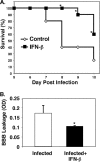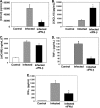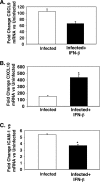Beta interferon suppresses the development of experimental cerebral malaria
- PMID: 21245265
- PMCID: PMC3067534
- DOI: 10.1128/IAI.00810-10
Beta interferon suppresses the development of experimental cerebral malaria
Abstract
Cerebral malaria (CM) is a major complication of Plasmodium falciparum infection, particularly in children. The pathogenesis of cerebral malaria involves parasitized red blood cell (RBC)-mediated vascular inflammation, immune stimulation, loss of blood-brain barrier integrity, and obstruction of cerebral capillaries. Therefore, blunting vascular inflammation and immune cell recruitment is crucial in limiting the disease course. Beta interferon (IFN-β) has been used in the treatment of diseases, such as multiple sclerosis (MS) but has not yet been explored in the treatment of CM. Therefore, we sought to determine whether IFN-β also limits disease progression in experimental cerebral malaria (ECM). Plasmodium berghei-infected mice treated with IFN-β died later and showed increased survival, with improved blood-brain barrier function, compared to infected mice. IFN-β did not alter systemic parasitemia. However, we identified multiple action sites that were modified by IFN-β administration. P. berghei infection resulted in increased expression of chemokine (C-X-C motif) ligand 9 (CXCL9) in brain vascular endothelial cells that attract T cells to the brain, as well as increased T-cell chemokine (C-X-C motif) receptor 3 (CXCR3) expression. The infection also increased the cellular content of intercellular adhesion molecule 1 (ICAM-1), a molecule important for attachment of parasitized RBCs to the endothelial cell. In this article, we report that IFN-β treatment leads to reduction of CXCL9 and ICAM-1 in the brain, reduction of T-cell CXCR3 expression, and downregulation of serum tumor necrosis factor alpha (TNF-α). In addition, IFN-β-treated P. berghei-infected mice also had fewer brain T-cell infiltrates, further demonstrating its protective effects. Hence, IFN-β has important anti-inflammatory properties that ameliorate the severity of ECM and prolong mouse survival.
Figures









Similar articles
-
Type I interferons contribute to experimental cerebral malaria development in response to sporozoite or blood-stage Plasmodium berghei ANKA.Eur J Immunol. 2013 Oct;43(10):2683-95. doi: 10.1002/eji.201343327. Epub 2013 Jul 19. Eur J Immunol. 2013. PMID: 23780878
-
Chemokine receptor CXCR3 and its ligands CXCL9 and CXCL10 are required for the development of murine cerebral malaria.Proc Natl Acad Sci U S A. 2008 Mar 25;105(12):4814-9. doi: 10.1073/pnas.0801544105. Epub 2008 Mar 17. Proc Natl Acad Sci U S A. 2008. PMID: 18347328 Free PMC article.
-
Role of ICAM-1 (CD54) in the development of murine cerebral malaria.Microbes Infect. 1999 Oct;1(12):961-8. doi: 10.1016/s1286-4579(99)80513-9. Microbes Infect. 1999. PMID: 10617927
-
Tumor necrosis factor alpha in the pathogenesis of cerebral malaria.Cell Mol Life Sci. 2003 Aug;60(8):1623-35. doi: 10.1007/s00018-003-2347-x. Cell Mol Life Sci. 2003. PMID: 14504653 Free PMC article. Review.
-
Pathogenesis of cerebral malaria: recent experimental data and possible applications for humans.Clin Microbiol Rev. 2001 Oct;14(4):810-20, table of contents. doi: 10.1128/CMR.14.4.810-820.2001. Clin Microbiol Rev. 2001. PMID: 11585786 Free PMC article. Review.
Cited by
-
Diagnosis of cerebral malaria: Tools to reduce Plasmodium falciparum associated mortality.Front Cell Infect Microbiol. 2023 Feb 9;13:1090013. doi: 10.3389/fcimb.2023.1090013. eCollection 2023. Front Cell Infect Microbiol. 2023. PMID: 36844403 Free PMC article. Review.
-
Neurons upregulate PD-L1 via IFN/STAT1/IRF1 to alleviate damage by CD8+ T cells in cerebral malaria.J Neuroinflammation. 2024 May 7;21(1):119. doi: 10.1186/s12974-024-03114-7. J Neuroinflammation. 2024. PMID: 38715061 Free PMC article.
-
An N-ethyl-N-nitrosourea (ENU)-induced dominant negative mutation in the JAK3 kinase protects against cerebral malaria.PLoS One. 2012;7(2):e31012. doi: 10.1371/journal.pone.0031012. Epub 2012 Feb 21. PLoS One. 2012. PMID: 22363534 Free PMC article.
-
IL-4 haplotype -590T, -34T and intron-3 VNTR R2 is associated with reduced malaria risk among ancestral indian tribal populations.PLoS One. 2012;7(10):e48136. doi: 10.1371/journal.pone.0048136. Epub 2012 Oct 24. PLoS One. 2012. PMID: 23110190 Free PMC article.
-
Activated Neutrophils Are Associated with Pediatric Cerebral Malaria Vasculopathy in Malawian Children.mBio. 2016 Feb 16;7(1):e01300-15. doi: 10.1128/mBio.01300-15. mBio. 2016. PMID: 26884431 Free PMC article.
References
Publication types
MeSH terms
Substances
Grants and funding
LinkOut - more resources
Full Text Sources
Other Literature Sources
Research Materials
Miscellaneous

